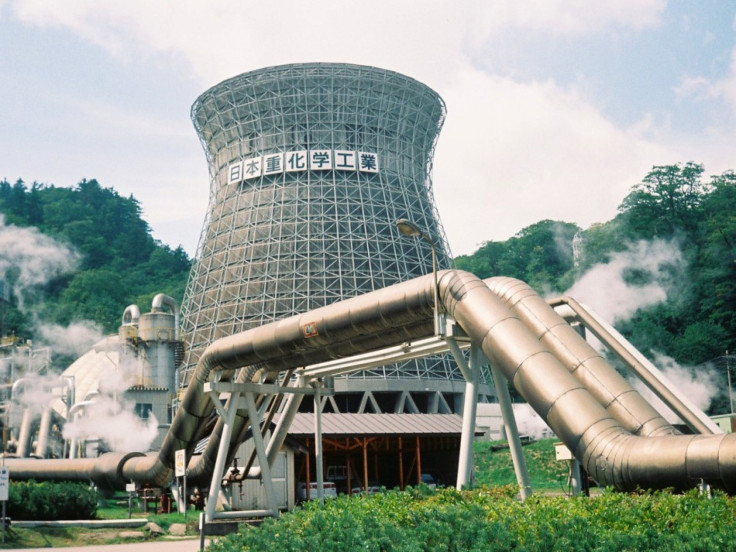Japan Turns To Geothermal Energy Amid Nuclear Uncertainty

Japan plans to build the nation's largest geothermal power plant in Fukushima Prefecture, the location of the massive earthquake and tsunami which led to last year's nuclear disaster.
The Asahi Shimbun, a leading newspaper in Japan, reported that the new geothermal plant will likely be built within Bandai-Asahi National Park, south of Fukushima city. The area has numerous active volcanoes.
The geothermal plant will generate 270,000 kilowatts, approximately a quarter of the output capacity of a nuclear plant. Investment will likely be in the tens of billions of yen, or hundreds of millions of dollars. Geothermal power generation harnesses the power of heat within the earth, in the form of steam. Typically this involves injecting heated water deep underground into bedrock, resulting in superheated steam that is used to power turbines generating electricity.
51 out of Japan's 54 total reactors remain offline. On Wednesday, Japanese Prime Minister Yoshihiko Noda announced delays restarting the Oi nuclear plant near Osaka, Japan second largest city.
Most of Japan's reactors are under suspended operations, undergoing a nation-wide safety review process that is proving to be costly to Japanese utility companies such as Tokyo Electric Power Corporation, which recently announced the cancellation of summer employee bonuses.
The decision to invest in geothermal technologies is an indication of Japan's eagerness to continue developing domestic sources of energy, strengthen national energy security, and move away from nuclear power.
In a twist of fate, the very seismic activity which caused the earthquake and tsunami that damaged the Fukushima nuclear plant last March may now provide a sustainable long-term energy source.
Between A Hot Rock And A Hard Place
However, nuclear power will be difficult to abandon, and geothermal energy may not be the best choice as a substitute.
Although a very seismically active nation, Japan has not built a geothermal power station since 1999. To fully compensate for nuclear generation with geothermal sources, Japan would need to build more than 200 Fukushima-sized plants across the country.
Dr. Robert Giegengack, Professor of Earth and Environmental Sciences at the University of Pennsylvania, said that running a financially profitable geothermal plant of worthwhile size anywhere in the world remains complicated and difficult.
Giegengack explained that Japan has good potential due to geography, resulting in the region enjoying a relatively high geothermal heat flow. Heat flow determines where plants can be constructed. Iceland, Yellowstone National Park, the North highlands of New Zealand and areas of Northern Italy are examples of prime locations for geothermal plants thanks to high heat flow.
Opportunities for geothermal energy along the Pacific Rim are underexploited, said Giegengack. Nevertheless, it would take about 20 years to build a new plant and get it operational.
Asahi Shimbun, however, notes that the new geothermal plant could completed in as quickly as 10 years.
In a country with a long history of devastating earthquakes and tsunamis along its eastern seaboard, nuclear reactor construction did not fully accomodate the knowledge of seismologists. Giegengack noted that in the United States, not one of the 104 reactors at 65 sites throughout the country faces the dual threat of being exposed to both an earthquake and a tsunami.
Japan, an island nation which looks abroad for much of its natural resources, is now stuck in a difficult situation. Continuing to rely on nuclear reactors seems dangerous, but in the meantime the country needs to increase reliance on imported coal and natural gas.
It would take many decades and vast sums for Japan to reach the status of Iceland, which produces about 30% of its electricity and heats nearly 90% of homes from geothermal sources.
Geothermal Infancy
Much of the technologies related to geothermal generation remain in their infancy stage and are of unproven financial viability.
The U.S. generates the most geothermal energy in the world, more than 3,000 megawatts over 77 plants. Many of these are located at The Geysers, a complex north of San Francisco in the Mayacamas Mountains of California.
In 2012, the Japanese Ministry of Economy, Trade, and Industry dedicated approximately 9 billion yen, or $109 million, to geothermal research and development.
Geothermal energy has drawn the attention of Japan's leading industrial groups. Mitsubishi Corp., Sumitomo Corp., Japan Petroleum Exploration Co. and Mitsui Oil Exploration Co. will all be involved in development of the Fukushima geothermal project.
© Copyright IBTimes 2024. All rights reserved.





















